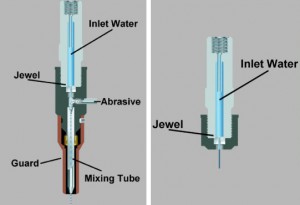HOW WATERJETS WORK
Waterjets cut with a supersonic stream of water that is so powerful it can cut through materials in one pass without shredding or crushing them. The Jet Edge water jet is created by pressurizing water up to 55,000 psi with a Jet Edge hydraulic waterjet intensifier pump or direct drive waterjet pump. The waterjet cutting action takes place as a result of the ultra-high pressure (UHP) water being forced through a pre-mounted waterjet orifice as small as .003 inches. In many applications, an abrasive material such as waterjet garnet is added to the waterjet to create an abrasive waterjet (also known as an abrasive jet) that can cut cleanly through virtually any material.
WHY CHOOSE WATERJETS?
THE ANSWER IS SIMPLE!
Waterjets are the most flexible and cost-effective cutting solution available. Waterjet cutting gives you a highly precise cut, and eliminates heat-affected zones, toxic fumes, recast layers, work hardening, and thermal stress.
WATERJET/ABRASIVEJET ADVANTAGES
Water Jets Cut Without Heat
Jet Edge waterjet technology is ideal for cutting heat-sensitive material. Costs due to thermal distortion of machine parts are eliminated. Risk of fatigue failure resulting from process-induced thermal stressing and associated material structural change is minimized.
Accurate Cutting
Jet Edge waterjets can hold an accuracy of 0.005 inch with a repeatability of 0.001 inch over the entire work envelope.
No Sharpening Required
Unlike conventional cutting tools, waterjets cut with a supersonic stream of water that never dulls. With waterjet, you will never need to shut down to sharpen or clean blades.
Minimize Dust and Toxic Fumes
The practical elimination of airborne dust particles, smoke, fumes, and contaminates from cutting materials such as asbestos and fiberglass greatly improves the work environment and reduces problems arising from operator exposure.
No Finishing Operation Required
Selection of appropriate cutting parameters such as operating pressure, material feed rate, abrasive particle size, and flow rate can eliminate the need for secondary operations. Jet Edge water jet systems also reduce machining time and production costs.
Non-Contact Cutting and Cleanliness
USDA-approved equipment designs promote the use of ultra-high pressure waterjet streams in the sanitary cutting of food products. Using UHP waterjet results in higher cutting speeds and the elimination of associated downtime incurred for cleaning and resharpening delicate blades. One of the biggest advantages of water jets is that fixturing associated with other machining methods is minimized.
Near Zero Lateral Cutting Force
Jet Edge water jet systems reduce fixturing costs plus avoid excessive stress to finished parts. Also, minimal lateral force simplifies material handling and allows cutting close to material edges.
Minimum Waste Material
With typical orifice diameters in the range of 0.003 – 0.030 inches, waterjet kerf width is kept to a minimum, thus maximizing material utilization.
Omni-Directional Cutting
Waterjet cut profiles are not confined to straight-line geometries. Part complexity is limited only by the motion control system specified and traditional start holes are eliminated.
Water Jets are Environmentally Friendly
Waterjets produce no hazardous waste, reducing waste disposal costs. They can cut off large pieces of reusable scrap material that might have been lost using traditional cutting methods. Parts can be closely nested to maximize material use, and the waterjet saves material by creating very little kerf. Waterjets use very little water (a half gallon to approximately one gallon per minute depending on cutting head orifice size), and the water that is used can be recycled using a closed-looped system. Waste water usually is clean enough to filter and dispose of down a drain. The garnet abrasive is a non-toxic natural substance that can be recycled for repeated use. Garnet usually can be disposed of in a landfill.

